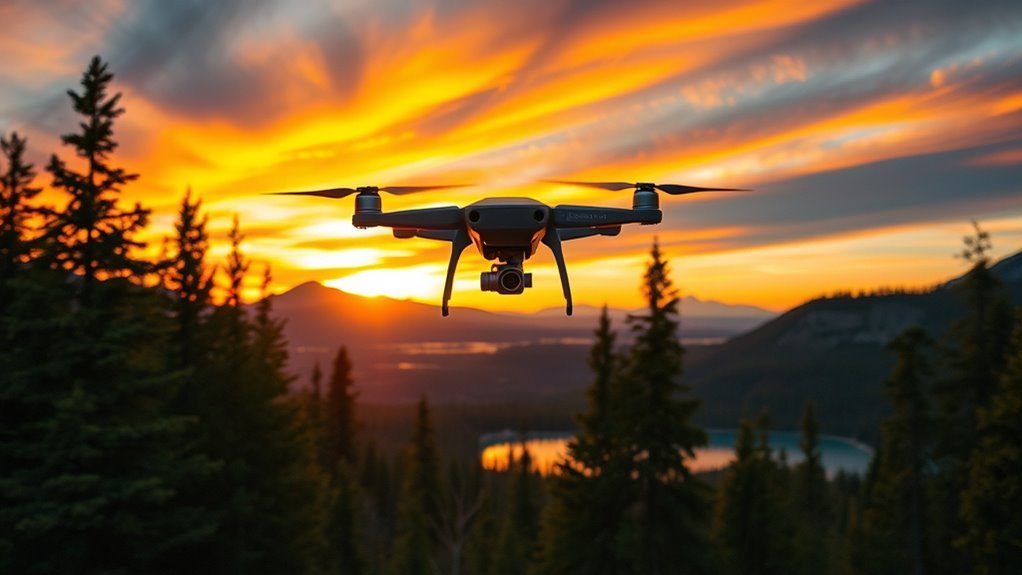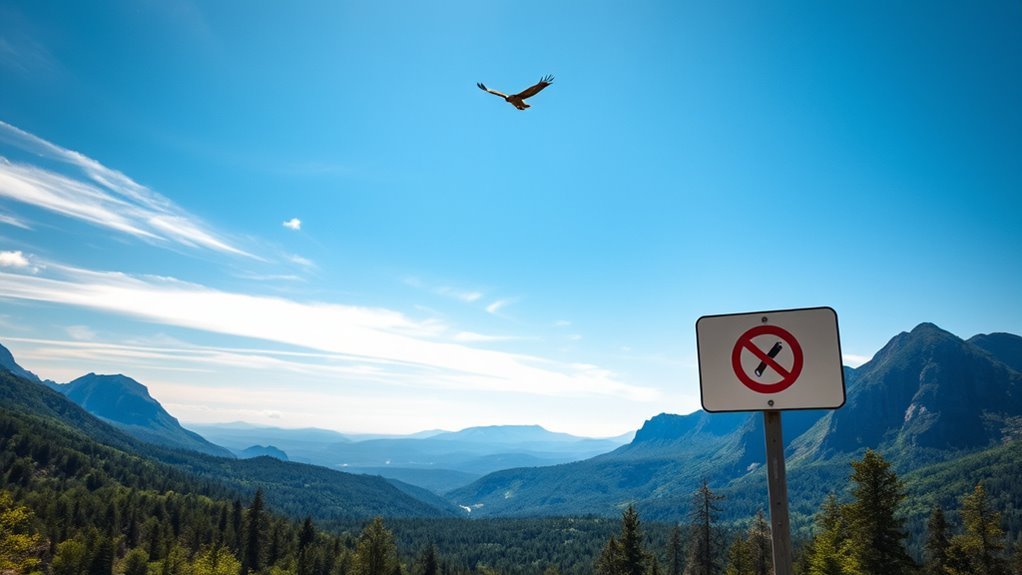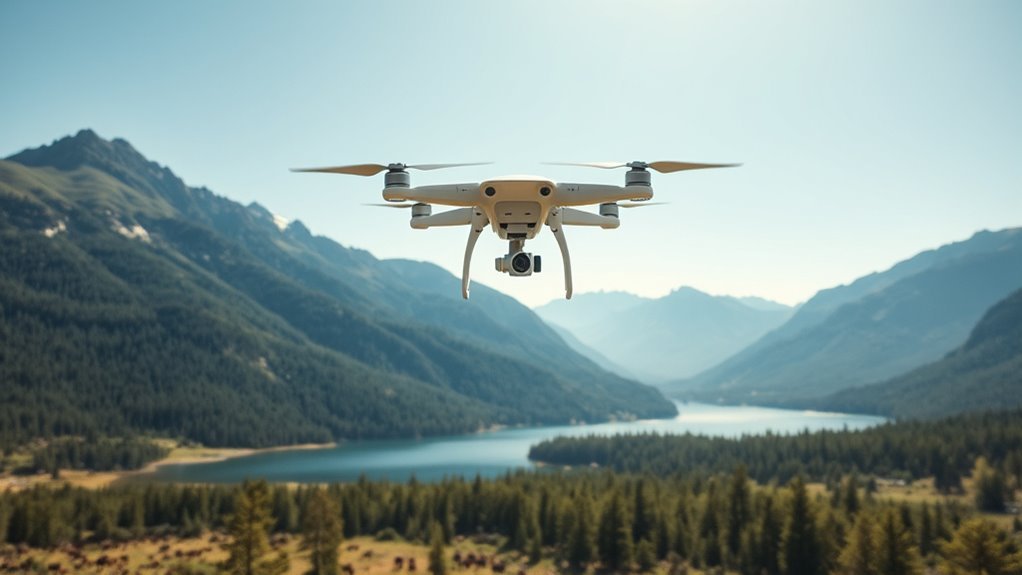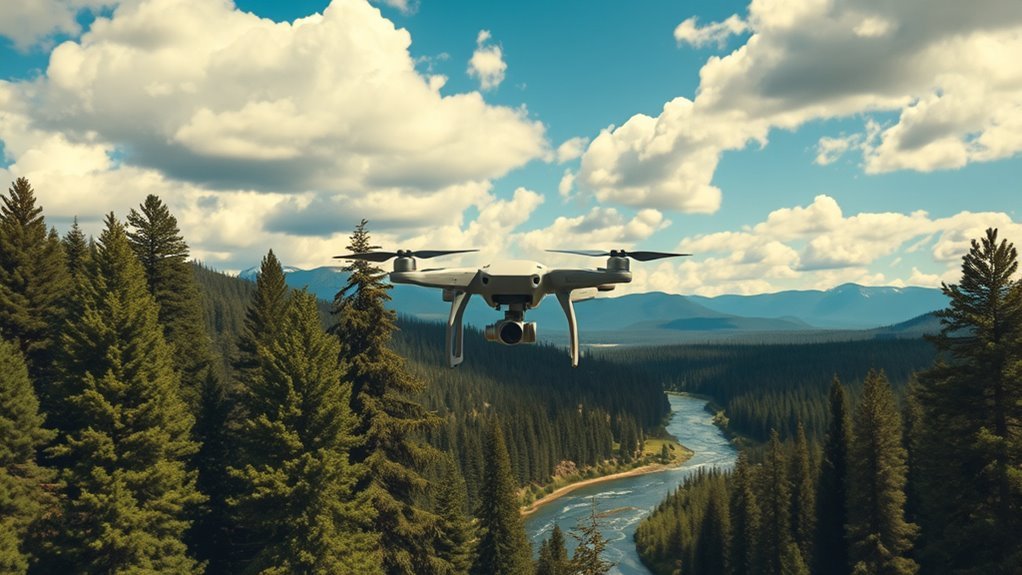To fly a drone in national parks, you must follow strict regulations. Be aware that drones are prohibited in many areas, especially near sensitive habitats and historic sites. You’ll need to obtain the necessary permits, like a special use permit for Yellowstone or an environmental assessment for Yosemite. Guarantee safety by maintaining your drone, avoiding crowds, and respecting wildlife. Adhering to these guidelines enhances everyone’s experience, and there’s more information to explore on this topic.
Understanding the Drone Regulations in National Parks

Although flying a drone can be an exciting way to capture the beauty of national parks, it is crucial to understand the regulations that govern their use. The Federal Aviation Administration (FAA) establishes strict federal regulations for drone types, ensuring safety and protecting the natural environment. Before you launch, familiarize yourself with operational guidelines, including altitude limits and no-fly zones within park boundaries. Different drone types have varying weight classifications, affecting registration requirements and operational permissions. Always check specific park regulations, as they may impose additional restrictions. By adhering to these rules, you can enjoy the freedom of flying your drone while contributing to the preservation of these stunning landscapes. Additionally, be aware that specific restrictions may apply to drone flights to ensure public safety and protect private privacy. Stay informed, and respect the regulations to enhance your flying experience.
Areas Where Drones Are Prohibited

When flying a drone in national parks, be aware that there are several key areas where drone use is strictly prohibited. These restrictions often apply within designated drone zones, which are typically located near sensitive wildlife habitats and historic sites. Additionally, any area within park boundaries that poses a risk to public safety or natural resources can be off-limits for drone activity. For instance, near visitor centers, campgrounds, and areas with heavy foot traffic, you’ll likely find strict regulations. Always check the specific park’s guidelines before launching your drone, as these rules are enforced to preserve the natural environment and guarantee visitor safety. Ignoring these prohibitions can lead to fines or other penalties, so stay informed and respectful.
Obtaining Necessary Permits and Permissions

Understanding the areas where drones are prohibited is just the first step; obtaining the necessary permits and permissions is equally important for compliant drone operation in national parks. You’ll need to submit a permit application that addresses specific permission requirements unique to each park.
| Park Name | Permit Application Required | Additional Permissions Needed |
|---|---|---|
| Yellowstone | Yes | Special Use Permit |
| Yosemite | Yes | Environmental Assessment |
| Glacier | Yes | Filming Permit |
Before flying, familiarize yourself with each park’s regulations and guarantee you meet all criteria. This preparation will help you enjoy your drone experience while respecting the natural beauty and regulations of these protected areas.
Safety Guidelines for Drone Operation
Before you take to the skies with your drone in a national park, it’s important to adhere to safety guidelines that protect both wildlife and fellow visitors. Start with thorough drone maintenance; verify your equipment is in top condition by checking battery levels, propellers, and cameras before every flight. Prioritize flight safety by avoiding crowded areas and maintaining a safe distance from wildlife and park structures. Familiarize yourself with local regulations, including altitude limits and no-fly zones, to avoid penalties. Always keep your drone within your line of sight and be prepared for sudden changes in weather. Following these guidelines not only enhances your flying experience but also guarantees you’re contributing to the preservation of these beautiful natural spaces. Additionally, be aware that drones must not interfere with firefighting efforts or law enforcement operations during your flight.
Respecting Wildlife and Other Visitors
Respecting wildlife and other visitors is essential for maintaining the natural balance of national parks while ensuring everyone has an enjoyable experience. When flying your drone, keep in mind that wildlife disturbance can have serious implications on animal behavior and ecosystems. Avoid flying near nesting sites or during sensitive periods, like mating seasons, to protect these species. Additionally, be aware of other visitors; your drone shouldn’t disrupt their experience. Keep your flight paths away from crowded areas and respect established guidelines. Engaging with nature should be about sharing the environment, not intruding upon it. By prioritizing wildlife and visitor experience, you contribute to a peaceful atmosphere where everyone can enjoy the beauty of national parks without unnecessary interference.
Frequently Asked Questions
Can I Fly a Drone During Special Events in National Parks?
When it comes to capturing special moments, drone etiquette is key. You’ll need to check event permissions since flying a drone during gatherings often requires prior authorization. Respect the rules to guarantee everyone enjoys the experience.
Are There Restrictions for Flying Drones at Night?
When it comes to night flying, you’ll face restrictions due to visibility concerns. Many regulations require proper lighting and adherence to safety guidelines, ensuring you can operate your drone effectively and responsibly after dark.
Do I Need Insurance to Fly a Drone in National Parks?
Imagine you’re capturing breathtaking footage of a canyon. While drone insurance isn’t legally required, having liability coverage can protect you from unexpected damages. It’s wise to contemplate insurance for peace of mind in adventurous flying.
What Happens if I Violate Drone Regulations in a National Park?
If you violate drone regulations in a national park, you could face penalties incurred, including fines or confiscation of your drone. Legal consequences may also arise, potentially affecting your future ability to fly in protected areas.
Can I Use My Drone for Commercial Purposes in National Parks?
While you might think flying a drone commercially in national parks is straightforward, you’ll need drone permits and potentially commercial licenses. Always check regulations, as national park rules can be strict regarding drone operations.

